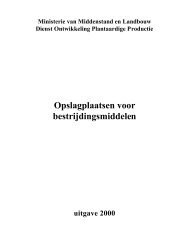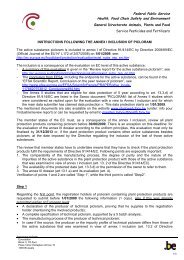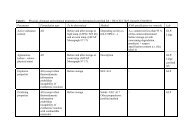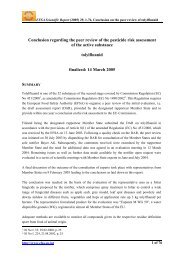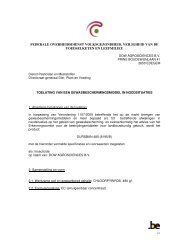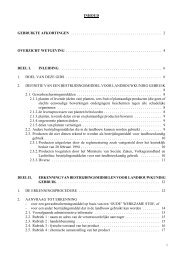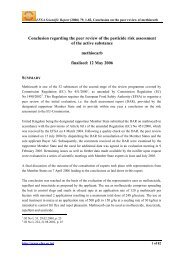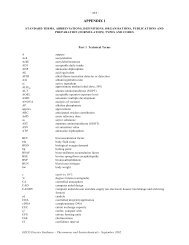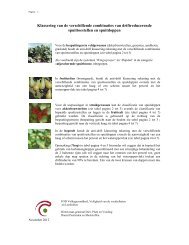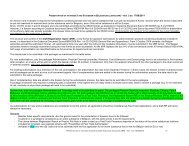Assessment of the Equivalence of Technical Materials - European ...
Assessment of the Equivalence of Technical Materials - European ...
Assessment of the Equivalence of Technical Materials - European ...
- No tags were found...
Create successful ePaper yourself
Turn your PDF publications into a flip-book with our unique Google optimized e-Paper software.
Appendix V How to judge what is an acceptable upper limit concentration for animpurity <strong>of</strong> toxicological concernThe following information can be taken into account when considering what is an appropriateupper limit for an impurity in an active substance (see also Appendix III for nitrosamines,polychlorinated dibenzo-p-dioxins and polychlorinated dibenz<strong>of</strong>urans):- O<strong>the</strong>r toxicity data may be available to establish a NOAEL for <strong>the</strong> impurity. Fur<strong>the</strong>rtoxicity data should only be requested if absolutely essential, especially if this involves animaltesting.- An acceptable upper limit may have already been agreed/proposed under 91/414/ECand/or 1107/2009 for this impurity in ano<strong>the</strong>r active e.g. 2,3-Diaminophenazine (DAP) and 2-amino-3-hydroxyphenazine (AHP) in benomyl and carbendazim.- An acceptable upper limit may have already been proposed for this impurity in <strong>the</strong>same or in a different active by ano<strong>the</strong>r authority e.g. by FAO or APVMA.- If <strong>the</strong> impurity is classified for adverse toxicological properties, <strong>the</strong> genericconcentration limits applicable for impurities (0.1% or 1%, see Annex I to regulation (EC)1272/2008) can be regarded as an acceptable upper limit unless a lower value is specified for<strong>the</strong> impurity in Annex VI to Regulation (EC) 1272/2008.- If specific concentration limits are proposed for an impurity in Annex VI to regulation(EC) 1272/2008, as updated from time to time by way <strong>of</strong> an Adaptation to <strong>Technical</strong> Progress(ATP), <strong>the</strong>re may be more than one concentration limit (i.e. classification may vary accordingto <strong>the</strong> concentration). In such a case, expert judgement will be needed to select <strong>the</strong> mostappropriate value.Genotoxic impurities are a particular concern. This is because for most genotoxic substances<strong>the</strong>re is uncertainty as to whe<strong>the</strong>r a scientifically supportable NOAEL can be established. As ageneral rule, genotoxic impurities should <strong>the</strong>refore not be present in <strong>the</strong> technical material tobe marketed (especially impurities considered to be genotoxic in vivo and/or to be genotoxiccarcinogens). However, it is important to apply expert judgement and case-by-caseconsideration.If <strong>the</strong>re is concern over <strong>the</strong> possibility <strong>of</strong> a genotoxic impurity being present in <strong>the</strong> technicalmaterial, some possible approaches are:a) To screen each batch using an appropriately sensitive assay (typically <strong>the</strong> Amestest). Any batch giving an equivocal or positive result in this assay should not be marketed.b) It may be appropriate to relate an acceptable upper limit concentration for animpurity to background levels <strong>of</strong> human exposure to genotoxins which occur naturally (e.g. to<strong>the</strong> concentration <strong>of</strong> a relevant genotoxin which occurs naturally in <strong>the</strong> human diet).Acceptance <strong>of</strong> this approach would be facilitated by a negative carcinogenicity study withtechnical material containing <strong>the</strong> impurity at a concentration equal to or above <strong>the</strong> limitconcentration being proposed.c) If a genotoxic impurity is present, <strong>the</strong> concentration should be kept “as low asreasonably achievable (ALARA)”: Kroes et al (2004) proposed a TTC <strong>of</strong> 0.15 µg/person/d fornon-potent genotoxins. However, until now <strong>the</strong>re has been no formal agreement within <strong>the</strong>EU <strong>of</strong> <strong>the</strong> TTC value that is applicable when genotoxicity is a concern for pesticide riskassessment. Additionally, <strong>the</strong> ALARA (“as low as reasonable achievable”) principle should27



